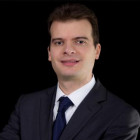Presentation Panel
Revolutionising Education with VR and the Metaverse
Date Friday, Nov 24 Time – Room Charlottenburg II
Uncover the educational revolution powered by the metaverse and VR in this session.
Witness practical applications of VR in universities, with speakers showcasing virtual tools in medical education, the advantages of virtual simulations in multi-campus teaching, and a healthcare mini-course utilising XR for student engagement. Experience the future of learning through immersive technologies.

Herwig Rehatschek
Director Executive Department Teaching with Media, Medical University of Graz, Austria
Dr. Herwig Rehatschek studied Computer Science and Electronics and received his M.Sc. and his Ph.D. from the University of Technology, Graz. From 1997 until 2008 he worked at the non-profit research company JOANNEUM RESEARCH. His main emphasis was on eLearning and digital media analysis. He participated in many international EC projects and also managed and co-ordinated some of them. In 1999 Dr. Rehatschek won the Austrian state price in the category learning, knowledge and culture. In 2008 he joined the Medical University of Graz with the main responsibility for the development of the eLearning platform of the university. Since then he was actively involved in the set-up and implementation of the LMS, the development of eLectures, the introduction of a new virtual microscope and the design of a teacher training course (eDidactics – http://www.edidactics.at). He won in 2012 the Dr. Michael Hasiba price for innovative teaching and in 2017 the Austrian state price „Ars Docendi“ for innovative teaching in the category “innovative teaching models having a huge number of students” by implementing a non-linear-story telling concept within first aid and emergency medicine. In 2017 he started a pilot trial with a new lecture recording system. Until begin of 2018 one hundred recordings were online and available to all students of the university. In 2019 a new software platform for the lecture recording system was introduced which also offered a video portal functionality. In 2020 subtitles were added. In 2021 the system was extended by livestreaming including a chat backchannel. By begin of 2022 more than 1500 recordings were available. In 2022 he started the project set-up of a Virtual Anatomy, a cross collaboration between two universities in Austria.
Links

Vesa Paajanen
Senior lecturer, University of Eastern Finland, Finland
Vesa Paajanen is a senior lecturer in animal physiology. In current position as a facilitator of online and blended learning at University of Eastern Finland he is using 50% of the working load on teaching higher education and rest time helping his colleagues to turn their teaching online and to develop pedagogically useful online learning environments. In higher education his is focused in Flipped Classroom & learning analytics to support each student in a personal way.
Links
Moderator

Martín Rodríguez Jugo
Director of Digital Learning & Online Solutions, IE University
Martin Rodriguez is the Director of Digital Learning & Online Solutions at IE University. This unit designs, produces and distributes IE learning materials (https://iepublishing.ie.edu), multimedia cases, simulations, MOOCs, VR & Immersive experiences, self-paced online courses, and different types of online programs. He has participated in a wide range of projects such as the development of learning materials including multi-player games and simulations, multimedia case studies, the launch and design of online programs, the design and use of learning analytics, virtual reality & immersive learning experiences, the implementation of AI strategies for learning, and many kinds of learning innovation projects.
Increase Learning Potential by Design of A Use Case-driven Virtual Anatomy Utilising a Strategic Cross-over University Collaboration, Herwig Rehatschek
This presentation discusses the use of virtual tools to enhance anatomy teaching in undergraduate medical education. Herwig Rehatschek will evaluate three technical scenarios for virtual teaching and define use cases for integrating these scenarios within teaching anatomy.
Herwig will explain how the use of virtual tools can help optimise student preparation for hands-on lessons and enhance the learning experience and learning gains. He will also present a low-cost solution for modeling and presenting 3D scans of bones, plastination, and wax models in an open-source learning management system.
The Exploration of XR in Healthcare: from Concept to Prototype - An Exciting Journey with Technology and Interdisciplinary Collaboration, Jane Søborg
This presentation will showcase a mini-course for healthcare students to work with XR, including ethics, scientific knowledge, and teamwork.
Jane Søborg will explain how to structure the course, work with theory, and make students collaborate on a product-based focus. She will also suggests XR-programs for students to work on and share insights on working with students across disciplines and different experience levels.
Importance of Virtual Simulations To Engage Students on a Flipped Classroom Course, Vesa Paajanen
This presentation will explain how the use of virtual simulations in multi-campus teaching can help engage students and improve their ability to reach learning goals.
Vesa Paajanen will provide insights on how to evaluate the benefits and limitations of virtual simulations in higher education by sharing a study at the University of Eastern Finland that found that virtual simulations increased the pass rate of flipped classroom students and were an important factor in course satisfaction.
